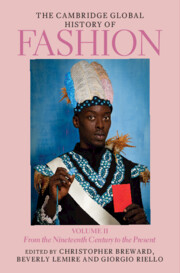Book contents
- The Cambridge Global History of Fashion
- The Cambridge Global History of Fashion
- The Cambridge Global History of Fashion
- Copyright page
- Contents for Volume II
- Figures for Volume II
- Maps for Volume II
- Table for Volume II
- Contributors for Volume II
- Preface
- Part IV Fashion, Modernism, and Modernity
- 21 Fashionable Masculinities in England and Beyond
- 22 Fashion in Capitalism
- 23 Fashion and Youth in Western Societies
- 24 Fashion and Time in China’s Twentieth Century
- 25 The Totalitarian State and Fashion in the Twentieth Century
- 26 Hollywood and Beyond
- 27 Fashion and Non-Fashion Cultures
- 28 Fashion and Hypermodernity
- Part V Fashion, Colonialism, and Post-Colonialism
- Part VI Fashion Systems and Globalization
- Index
- References
28 - Fashion and Hypermodernity
from Part IV - Fashion, Modernism, and Modernity
Published online by Cambridge University Press: 04 August 2023
- The Cambridge Global History of Fashion
- The Cambridge Global History of Fashion
- The Cambridge Global History of Fashion
- Copyright page
- Contents for Volume II
- Figures for Volume II
- Maps for Volume II
- Table for Volume II
- Contributors for Volume II
- Preface
- Part IV Fashion, Modernism, and Modernity
- 21 Fashionable Masculinities in England and Beyond
- 22 Fashion in Capitalism
- 23 Fashion and Youth in Western Societies
- 24 Fashion and Time in China’s Twentieth Century
- 25 The Totalitarian State and Fashion in the Twentieth Century
- 26 Hollywood and Beyond
- 27 Fashion and Non-Fashion Cultures
- 28 Fashion and Hypermodernity
- Part V Fashion, Colonialism, and Post-Colonialism
- Part VI Fashion Systems and Globalization
- Index
- References
Summary
The March 2020 issue of Vogue Italia was titled ‘The Real Issue’ and portrayed on the cover Ida, a digitally-created model photographed by Mert and Marcus in collaboration with Vogue art director Ferdinando Verderi. As the editor-in-chief Emanuele Farneti explains, the idea was to reflect on the current meshing between virtual and real as condition of existence – the ‘osmosis of these two worlds’ especially at the time of the coronavirus when citizens’ freedom to move has been drastically limited. The fake model Ida, suggests Farnesi, is evidence of the ways digital life is overcoming physical life in practices of representation and, on the other hand, is an evocation of an absence of corporeality and carnality in this digital world.
- Type
- Chapter
- Information
- The Cambridge Global History of FashionFrom the Nineteenth Century to the Present, pp. 994 - 1020Publisher: Cambridge University PressPrint publication year: 2023



